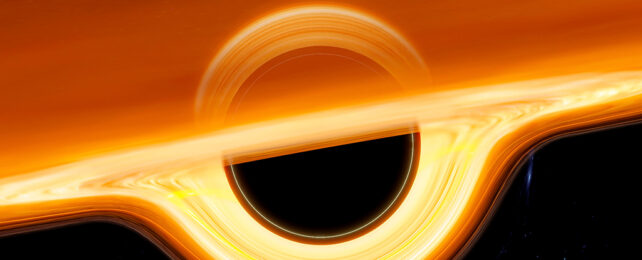Black holes are powerful gravitational engines. So you might imagine that there must be a way to extract energy from them given the chance, and you'd be right.
Certainly, we could tap into all the heat and kinetic energy of a black hole's accretion disk and jets, but even if all you had was a black hole in empty space, you could still extract energy from a trick known as the Penrose process.
First proposed by Roger Penrose in 1971, it is a way to extract rotational energy from a black hole. It uses an effect known as frame dragging, where a rotating body twists nearby space in such a way that an object falling toward the body is dragged slightly along the path of rotation.
We've observed the effect near Earth, though it is tiny. Near a rotating black hole, the effect can be huge. So strong that within a region known as the ergosphere objects can be dragged around the black hole at speeds greater than light in free space.
Roughly, the Penrose process is to fly into the ergosphere of a swiftly spinning black hole, and then release a bit of mass or radiation into the black hole. The resulting rotational kick sends you away from the black hole faster than you approached it. The extra energy you get is balanced by slowing down the black hole's rotation.
This process can in theory extract up to 20 percent of the black hole's mass energy, which is huge. In comparison, fusing hydrogen into helium only yields about 1 percent of the mass energy.
Of course, theoretical physicists are never satisfied. If you can extract 20 percent of the mass energy from a black hole, why not more?
This is the focus of a recent paper, though it should be noted that it focuses on a more abstract idea of a black hole than we see in the Universe.
Simple black holes can be characterized by three things: mass, rotation, and electric charge. The black holes we observe have the first two, but since matter is electrically neutral, not the third. This paper focuses on charged black holes.
Our Universe is also expanding and can be roughly described by a solution to Einstein's equations known as de Sitter space. It describes an empty universe with a positive cosmological constant. Anti-de Sitter space (AdS) would be a universe with a negative cosmological constant.
Although AdS doesn't describe our Universe, it allows for a few mathematical tricks theorists love, so it is often used to explore the limits of general relativity. This paper specifically looks at a charged black hole in anti-de Sitter space.
Although this study is entirely hypothetical, it's interesting as a "what-if" scenario. Rather than extracting energy from a black hole's rotation, the authors look at how to extract energy through particle decay using the Bañados-Silk-West (BSW) effect.
Using some kind of electromagnetic or physical confinement mirrors, particles can be reflected back and forth near the event horizon, gaining energy from the black hole until they decay as usable energy.
The problem with this idea, as the authors show, is that this can lead to a runaway effect where particle energy amplifies particle energy in a feedback look, leading to what's known as a black hole bomb. So if you find yourself building a power plant near a charged black hole in an anti-de Sitter universe, tread carefully.
But more interesting is that the authors also looked at the case of a charged black hole in an otherwise empty anti-de Sitter universe. In this case, energy would also be extracted from the black hole.
Instead of mirrors, the structure of space-time itself would act as a kind of confinement chamber. So the charged black hole would release energy on its own. It would be similar to Hawking radiation, but in this case, it doesn't rely upon quantum gravity. The authors also found that this case doesn't lead to a black hole bomb.
As mentioned earlier, none of this applies to real black holes in our Universe. As far as we know, the Penrose process is the best we could really do.
But studies like this are useful because of what they reveal about the fundamental nature of space and time. And now we know that even in a strange anti-universe we can only imagine, black holes can release energy over time.
This article was originally published by Universe Today. Read the original article.
